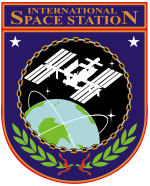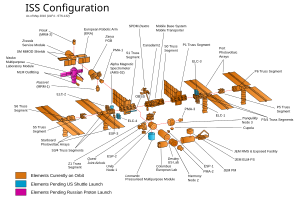International Space Station
From Wikipedia, the free encyclopedia
International Space Station
 |
| The International Space Station on 23 May 2010 as seen from the departing Space Shuttle Atlantis during STS-132. |
 |
| ISS Insignia |
| Station statistics |
| NSSDC ID | 1998-067A |
| Call sign | Alpha |
| Crew | 6 |
| Launch | 1998–2011 |
| Launch pad | KSC LC-39,
Baikonur LC-1/5 & LC-81/23 |
| Mass | 369,914 kg (815,520 lb) |
| Length | 51 m (167.3 ft)
from PMA-2 to Zvezda |
| Width | 109 m (357.5 ft)
along truss, arrays extended |
| Height | c. 20 m (c. 66 ft)
nadir–zenith, arrays forward–aft
(27 November 2009)[dated info] |
| Pressurised volume | 837 m3
(29,561 cu ft) |
| Atmospheric pressure | 101.3 kPa (29.91 inHg, 1 atm) |
| Perigee | 347 km (187 nmi) AMSL
(18 June 2010) |
| Apogee | 360 km (194 nmi) AMSL
(18 June 2010) |
| Orbital inclination | 51.6 degrees |
| Average speed | 7,706.6 m/s
(27,743.8 km/h, 17,239.2 mph) |
| Orbital period | 91 minutes |
| Days in orbit | 4351
(19 October 2010) |
| Days occupied | 3640
(19 October 2010) |
| Number of orbits | 68295
(19 October 2010) |
| Orbital decay | 2 km/month |
Statistics as of 23 May 2010
(unless noted otherwise) |
| References: [1][2][3][4][5] |
| Configuration |
 |
Station elements as of 18 May 2010 (2010 -05-18)[update]
(exploded view) |
The International Space Station (ISS) is an internationally developed research facility that is being assembled in low Earth orbit. On-orbit construction of the station began in 1998 and is scheduled for completion by late 2011. The station is expected to remain in operation until at least 2015, and likely 2020.[6][7] With a greater cross-sectional area than that of any previous space station, the ISS can be seen from Earth with the naked eye,[8] and is by far the largest artificial satellite that has ever orbited Earth.[9] The ISS serves as a research laboratory that has a microgravity environment in which crews conduct experiments in biology, chemistry, medicine, physiology and physics, as well as astronomical and meteorological observations.[10][11][12] The station provides a unique environment for the testing of the spacecraft systems that will be required for missions to the Moon and Mars.[13] The ISS is operated by Expedition crews of six astronauts and cosmonauts, with the station programme maintaining an uninterrupted human presence in space since the launch of Expedition 1 on 31 October 2000, a total of 9 years and 353 days. The programme is thus approaching the current record for uninterrupted human presence on a space station, set aboard Mir, of 3,644 days (8 days short of 10 years), with the ISS expected to take the record on 23 October 2010.[14] As of 25 September 2010, the crew of Expedition 25 is aboard.[15]&0000000000000009000000&0000000000000353000000 (2010 -09-25)[update]
The ISS is a synthesis of several space station projects that include the American
Freedom, the Soviet/Russian
Mir-2, the European
Columbus and the Japanese
Kibō.
[16][17] Budget constraints led to the merger of these projects into a single multi-national programme.
[16] The ISS project began in 1994 with the
Shuttle–Mir programme,
[18] and the first module of the station,
Zarya, was launched in 1998 by Russia.
[16] Assembly continues, as pressurised modules, external trusses, and other components are launched by American
space shuttles, Russian
Proton rockets and Russian
Soyuz rockets.
[17] As of May 2010
[update], the station consists of fourteen pressurised modules and an extensive
integrated truss structure (ITS).
Power is provided by sixteen
solar arrays mounted on the external truss, in addition to four smaller arrays on the Russian modules.
[19] The station is
maintained at an orbit between 278 km (173 mi) and 460 km (286 mi) altitude, and travels at an average speed of 27,743.8 km/h (17,239.2 mph), completing 15.7 orbits per day.
[20]Operated as a joint project between the five participant space agencies, the station's sections are controlled by mission control centres on the ground operated by the American
National Aeronautics and Space Administration (NASA), the
European Space Agency (ESA), the
Russian Federal Space Agency (RKA), the
Japan Aerospace Exploration Agency (JAXA) and the
Canadian Space Agency (CSA).
[21][22] The ownership and use of the space station is established in intergovernmental treaties and agreements
[23] that allow the
Russian Federation to retain full ownership of its own modules in the Russian Orbital Segment,
[24] with the
US Orbital Segment, the remainder of the station, allocated between the other international partners.
[23] The cost of the station has been estimated by ESA as €100 billion over 30 years,
[25] and, although estimates range from 35 billion dollars to 160 billion dollars, the ISS is believed to be the
most expensive object ever constructed.
[26] The financing, research capabilities and technical design of the ISS programme have been criticised because of the high cost.
[27][28] The station is serviced by
Soyuz spacecraft,
Progress spacecraft, space shuttles, the
Automated Transfer Vehicle and the
H-II Transfer Vehicle,
[22] and has been visited by
astronauts and cosmonauts from 15 different nations.
[9]



